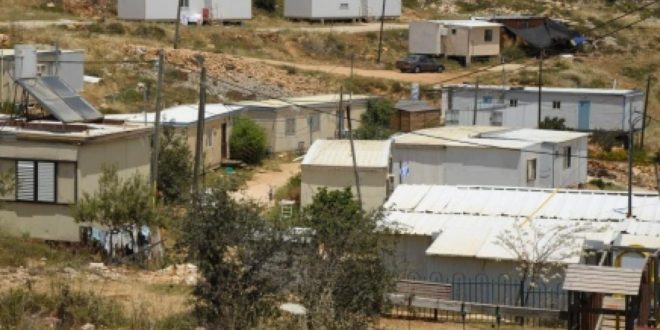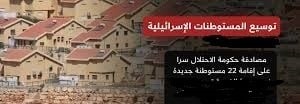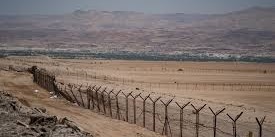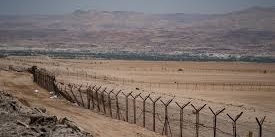By: Madeeha Al-A’raj
New tenders for the construction of 96 settlement units in the Adam settlement, northeast of the occupied city of Jerusalem were announced by the Israeli Occupation Municipality in Jerusalem, part of which a tender J/C/82-2020 to encircle the occupied city with a settlement cordon that can expand the settlement of Givat Hamtwas, where 680 settlement units will be built on private Palestinian lands.
According to Israeli sources, the Israeli Settlements Council in the occupied West Bank has completed the planning procedures for building 4,000 new settlement units in various Israeli settlements, awaiting final approval from Army Minister, Benny Gantz.The plan includes the construction of housing units outside the settlement blocs and in remote and isolated settlements, such as the settlements of Ravva and Tabuh, in addition to allocating 1,000 settlement units for ultra-Orthodox Jews.
The list of settlement plans published by the “Yesha” settlement council showed the settlers’ intention to build 650 settlement units in the “Tel Zion” settlement, 360 settlement units in the Emmanuel settlement east of Qalqilya, 377 in Kedumim, 192 in Sha’arei Tikva, 136 in Taffouh, 90 in Dolf and 32 settlement units in the Ma’ale Adumim settlement near Jerusalem, besides, the construction of 193 settlement units in the “Efrat” settlement near Bethlehem, 179 settlement units in the Einav settlement east of Tulkarm, 168 settlement units in Talmon, 136 in Givat Ze’ev, 107 in Hinamit, 93 in Tzofim and 64 in Revava and 136 in Pisgat Ze’ev, near Jerusalem. According to the list, there are 10 settlements that are considered relatively isolated; the settlements of Revava and Taffouh are of them.
Within the context of restricting movement of the Jerusalemites, the occupation municipality in Jerusalem approved a plan to expand the smart monitoring systems and the network of cameras in all areas of contact and confrontations in the occupied city, as they installing cameras in other settlements, at junctions and other locations around the city. Last week, a new tunnel and excavations were uncovered by the “Elad” settler association, in complete secrecy, 130 meters from the southeastern wall of the Al-Aqsa Mosque.
Evidence for the secret construction of the tunnel is that the workers and crews of the occupation and the settlement association brought equipment and machinery into the tunnel, which is adjacent to the “Ein al-Adara” water complex that the Canaanites dug, all the way to the Ein Silwan underground complex with a length of 533 meters, which is a closed military area that no one can enter. Excavations are carried out underground at a depth of 40 meters, while the opening of the tunnel is from 2 to 3 meters.
Meanwhile, the “Temple Groups” called for organizing mass incursions into Al-Aqsa Mosque during the “Hebrew Passover” holiday, in mid-April, and offering sacrifices inside the courtyards of the Temple Mount. The call to storm Al-Aqsa was published on social networks in the name of the “Temple Congregation Staff”, accompanied by a picture of a small lamb as a symbol of the sacrifice that the rabbis threaten to slaughter at Al-Aqsa during the “Hebrew Passover” this year. The call for mass incursions and the establishment of Biblical prayers and Talmudic rituals inside Al-Aqsa Square came after a meeting held by a group of rabbis in Al-Buraq Square and their provocative tour in the courtyards of the Haram last week
List of Israeli Occupation and Settlers’ Assaults over the Last Week
Documented by the National Bureau:
Jerusalem:
- Storming the Al-Aqsa Mosque from the Morocan Gate, guarded by the Special Forces.
- Renewing the closure of 28 Palestinian institutions, associations and bodies in the occupied city of Jerusalem, primarily Orient House and Prisoner Club, and others.
- Dangers of demolishing the house of the Jerusalemite prisoner, Fadi Alyan, and a “tent” for the family, and stables for horses in the town of Al-Isawiya, northeast of occupied Jerusalem,
- Injuring Ahmed Abu Khdeir, 20, from Shuafat, after settlers attacked him in occupied Jerusalem.
Hebron:
- Burning woods for construction and stealing light equipment from citizens in Birin village, south of Hebron.
- Preventing farmers from accessing their lands in the town of Beit Ummar, adjacent to the “Karmi Tzur” settlement, which is built on the town’s lands?
- Attacking a number of citizens’ homes in the center of Hebron on Al-Shallala Street.
- Attacking Palestinian settlers and human rights defenders in the village of Al-Tawani and the hills south of Hebron.
Ramallah:
- Preventing farmers from accessing their lands to plow them in the Rafid and Al-Mughrabat areas in the town of Sinjil, north of Ramallah, an area under threat of seizure, and they were forced to leave the area.
- Attacking citizens’ vehicles with stones at the Ein Ayoub junction near the village of Kharbatha Bani Harith, west of Ramallah, causing damage to a number of them.
- Attacking citizens’ vehicles with stones and empty bottles on Ramallah-Nablus Street, near Silwad town, northeast of Ramallah. Fired live bullets, wounding a boy who was admitted to hospit.
Nablus:
- Razing lands in the Qusra town, south of Nablus to expand the settlement of “Majdolim” and uprooted more than 300 perennial olive trees. Meanwhile, settlers built settlement streets on several hills in Qusra to facilitate control of the lands in order to control the hills near to settlements, and isolating Palestinian villages from each other.
- Bulldozing lands belonging to the village of Al-Sawiya, south of Nablus, surrounding the settlement of “Eli”
- Attacking citizens’ vehicles with stones near the entrance to the evacuated “Homash” settlement, on the Jenin-Nablus road, causing material damage. Settlers also attacked citizens’ vehicles with stones near the entrance to the town of Beit Furik, east of Nablus, causing damage to some of them.
- Attacking citizens’ vehicles near the “Yitzhar” settlement, south of Nablus, causing damage to a number of them
Qalqilia:
- Oder to stop construction on two agricultural plots in the town of Jayyous, east of Qalqilya, behind the apartheid wall, belongs to Ahmed Abu al-Adl and Hussein Saleh.
Jordan Valley:
- Establishing a new outpost in the northern Jordan Valley, where they put road signs and dug some holes, which indicates that these works are the nucleus of a new outpost in the northern Jordan Valley.
- Stop construction work of a house in the Fasayel Al-Fouqa, north of Jericho, owned by Sanad Nawara.
- Releasing a large herd of cows in the “Um Quba” area in the northern Jordan Valley to graze in it, planted with wheat and barley, which led to the destruction of hundreds of dunums of them.
- Seizing a crane belonging to Salim Moussa, from the town of Arraba under the pretext that the area is a military zone.
 المكتب الوطني للدفاع عن الارض ومقاومة الاستيطان منظمة التحرير الفلسطينية
المكتب الوطني للدفاع عن الارض ومقاومة الاستيطان منظمة التحرير الفلسطينية




